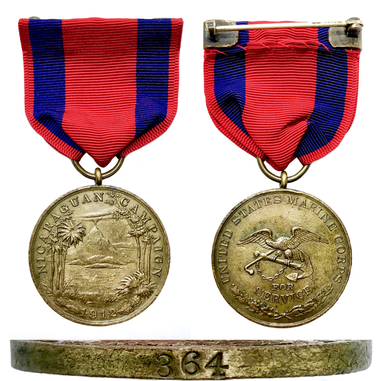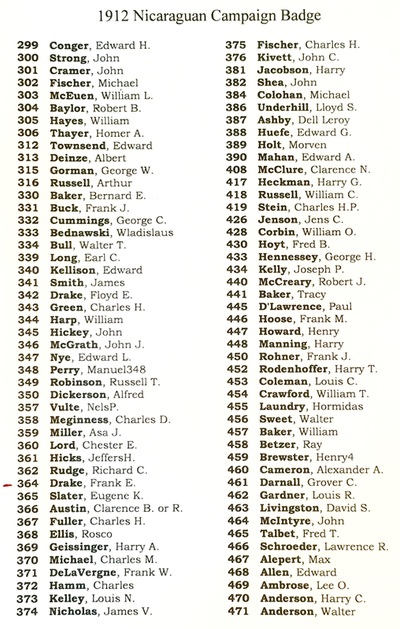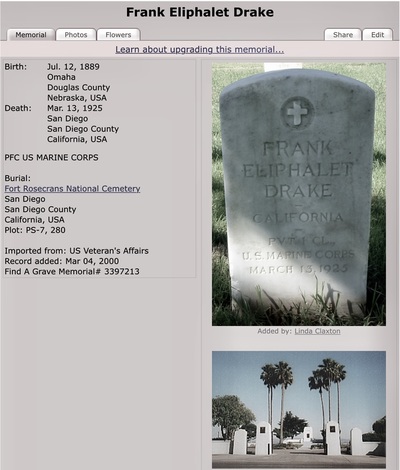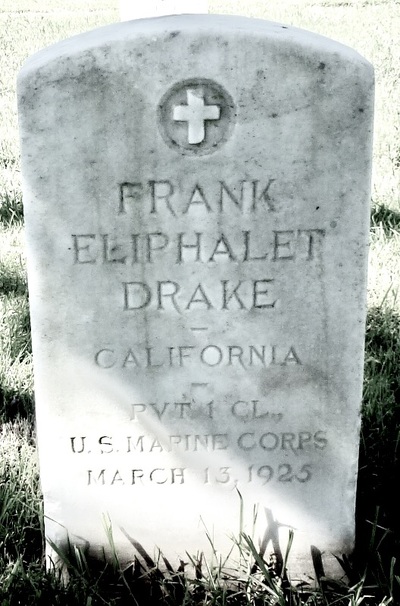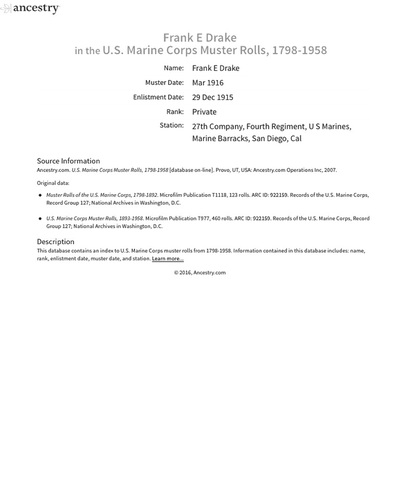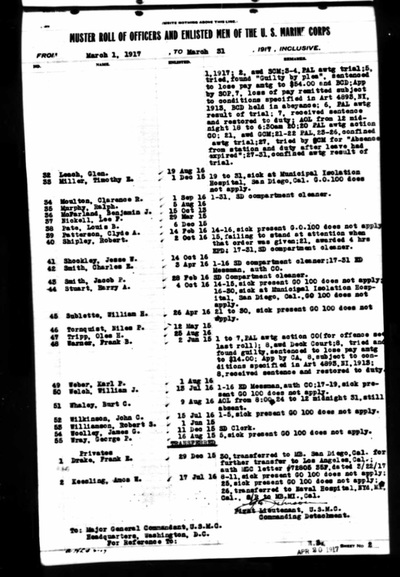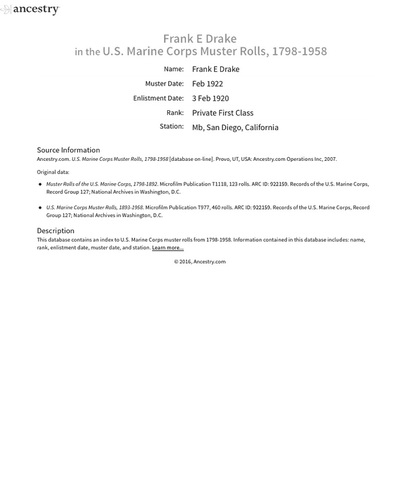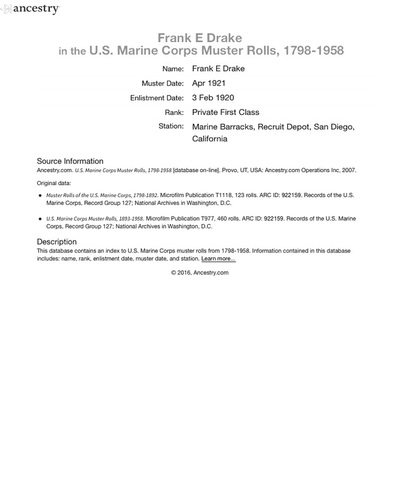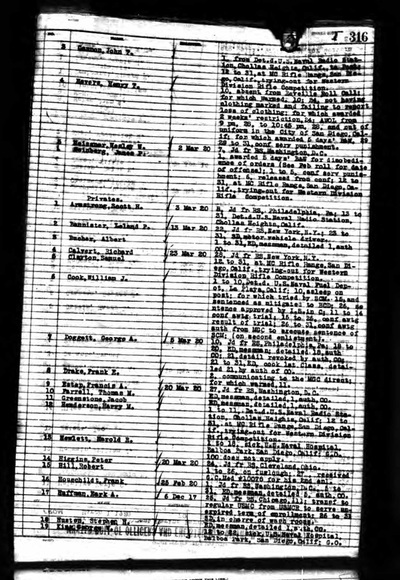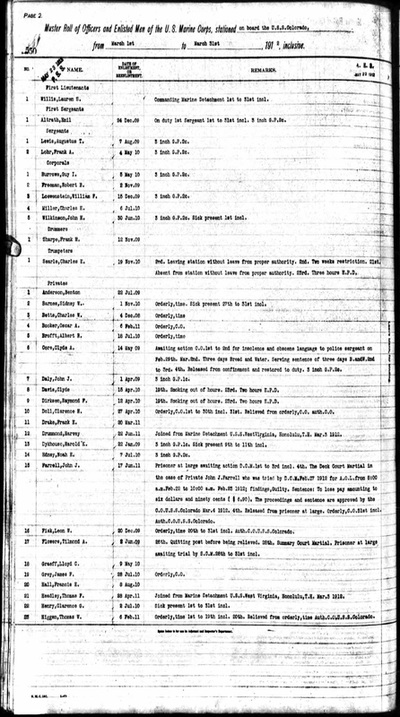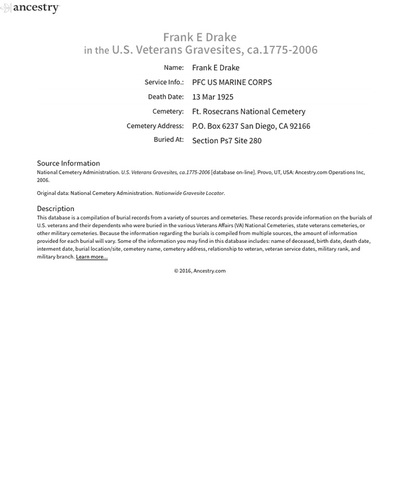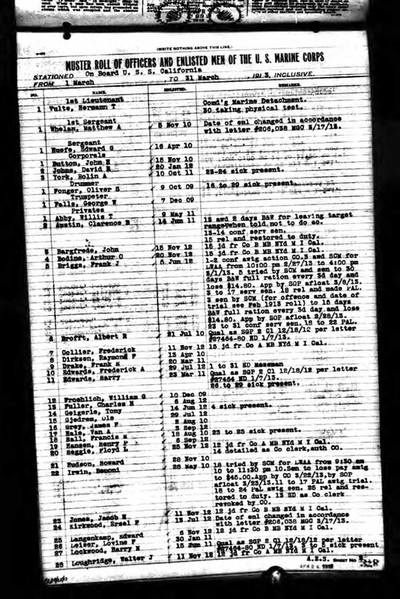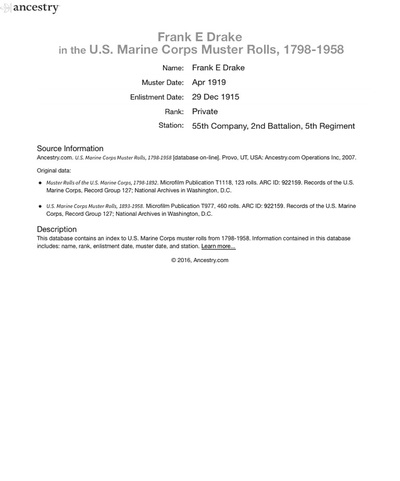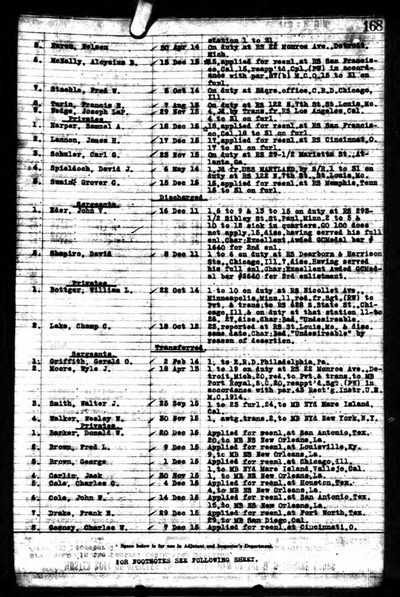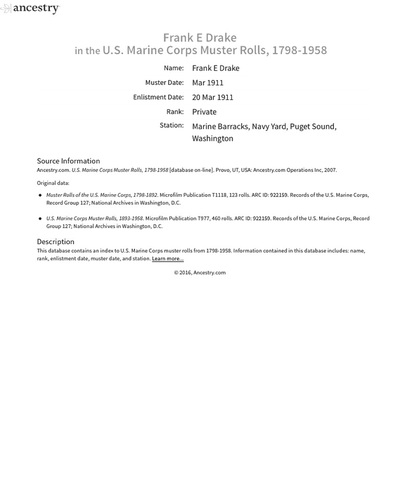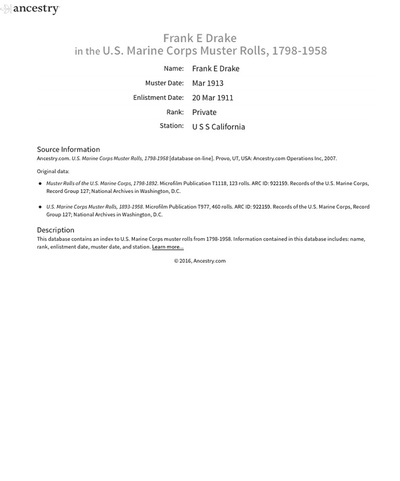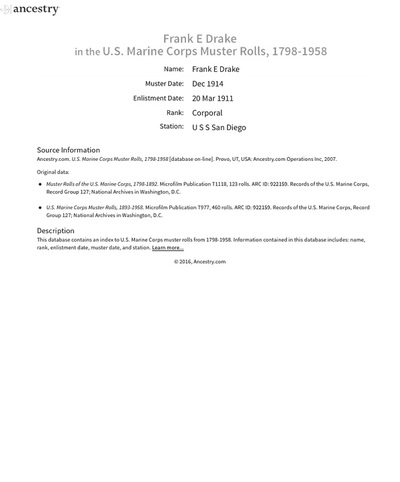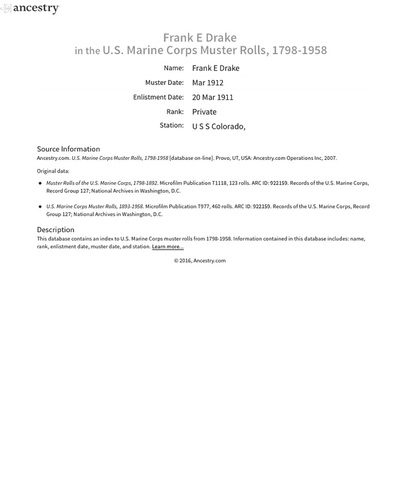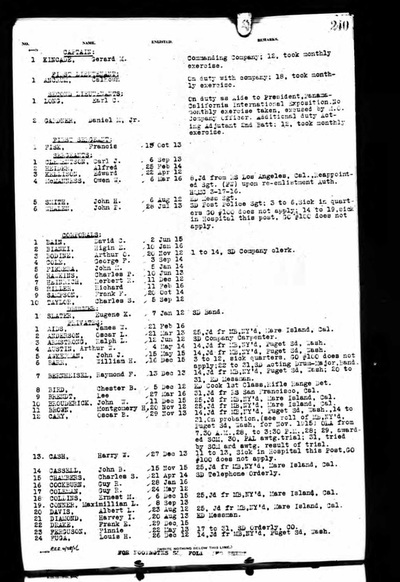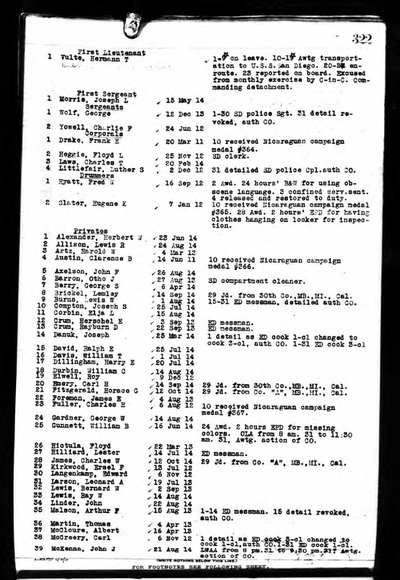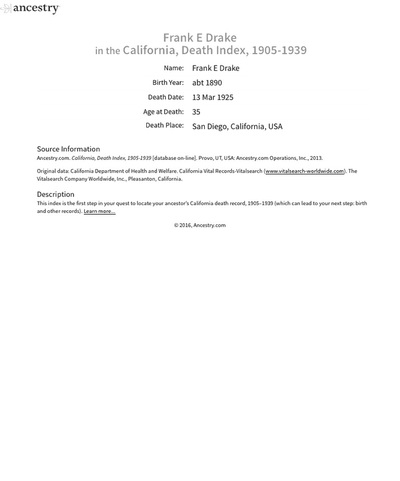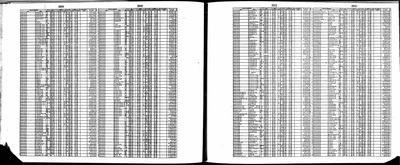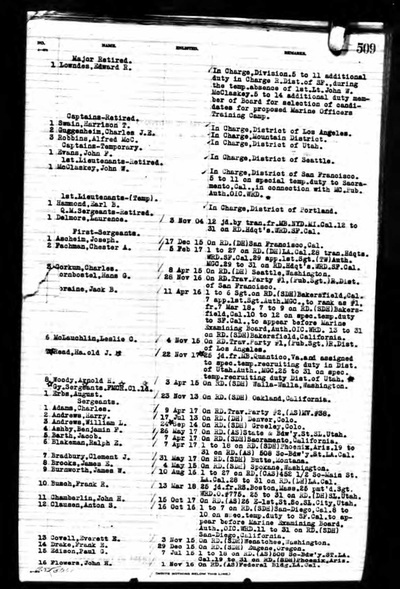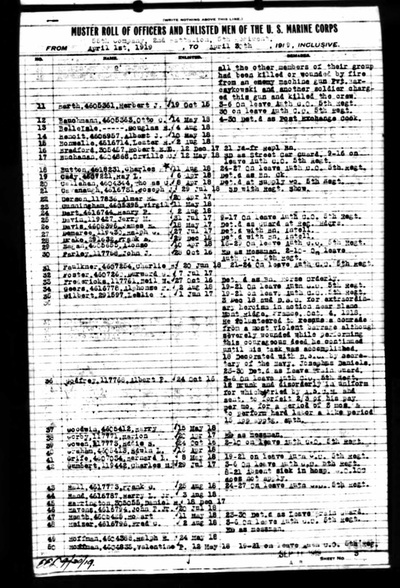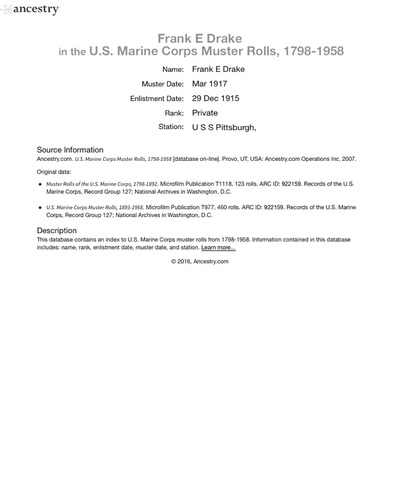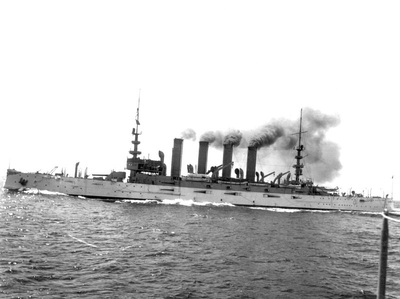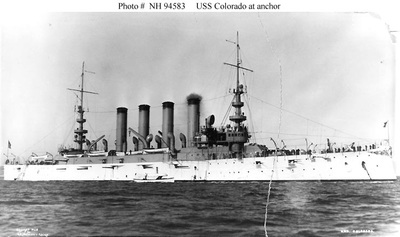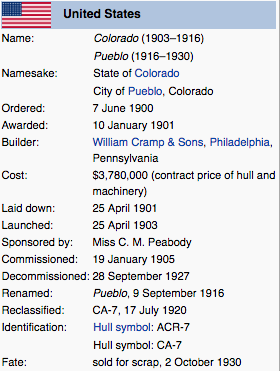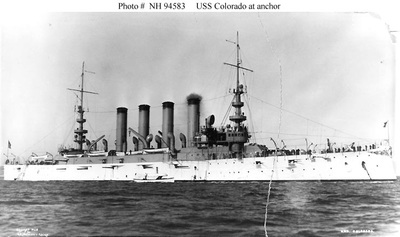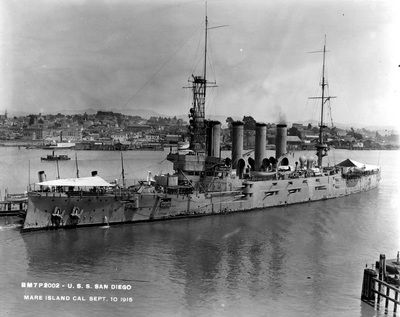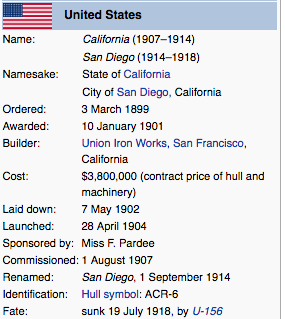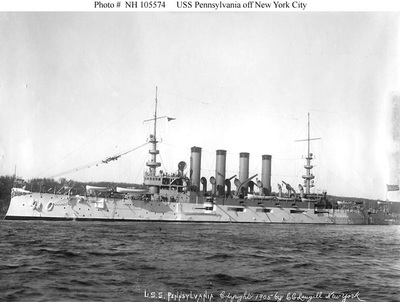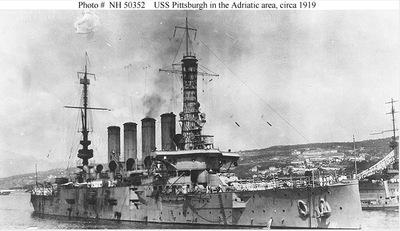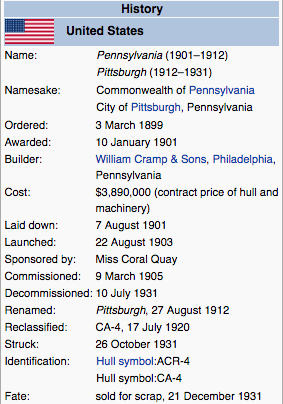1908 "BB&B" 1912 Nicaruguan Campaign Medal
#364
Frank E. Drake
Frank E. Drake
Sergeant Frank E. Drake
Frank E. Drake (serial #291632) was born in 1890, he enlisted in the United States Marine Corps March 20th 1911. He was stationed on the U.S.S. Colorado from 1911-1912. Drake was then stationed on the U.S.S. California throughout 1913. In July 1914 He was stationed on the former U.S.S. California renamed U.S.S. San Diego. In December 1914 Private Drake was awarded the 1912 Nicaraguan Campaign Medal #364 for his service in Nicaragua on the U.S.S. Colorado. Private Drake's enlistment ended in March 1915. On April 13th 1915 he was awarded Good Conduct Medal #4987 & he re-enlisted in December 1915 in Fort Worth Texas. Records show him back on the U.S.S. San Diego in 1916 as well as the U.S.S. Pittsburgh in 1917. In June of 1918 Drake was serving with the 51st Company 5th Regiments USMC American Expeditionary Force & he was involved in the Addenda Battle in France July 1919. Drake was discharged again from the USMC on Feb. 3rd 1920 & he re-enlisted Feb. 5th 1920. Private Drake was discharged from the USMC Feb, 28th 1922 & awarded the Second Award Good Conduct bar. Drake reached the rank of Sergeant during World War I but retired as a Private 1st Class. Frank E. Drake passed away March 13th 1925.
U.S.S. COLORADO
The second USS Colorado (ACR-7/CA-7), also referred to as "Armored Cruiser No. 7", and later renamed Pueblo, was a United States Navy Pennsylvania-class armored cruiser. She was launched on 25 April 1903 by William Cramp and Sons, Philadelphia; sponsored by Miss C. M. Peabody, and commissioned on 19 January 1905, Captain D. Kennedy in command.
Pre-World War I
Joining the Atlantic Fleet on 11 October 1905, Colorado trained and took part in drills along the east coast and in the Caribbean — as well as participating in ceremonies – until 7 September 1906, when she sailed for duty on the Asiatic Station. After cruising to Japan and China to represent American interests in the Far East, she returned to the west coast on 27 September 1907 for exercises along the Californian and Mexican coasts, in the Hawaiian Islands, and off Central and South America. She served again in the Far East from September 1909 – February 1910.
Ceremonial visits and receptions for dignitaries highlighted the next two years, and from November 1911 – July 1912, Colorado returned to the Far East for duty. Between August and November, she sailed to land and support expeditionary troops at Corinto, Nicaragua, then patrolled Mexican waters until placed in reduced commission at Puget Sound Navy Yard on 17 May 1913.
Once more in full commission from 9 February-26 September 1915, she continued on active duty as flagship of the Pacific Reserve Fleet, patrolling in Mexican waters during the revolution and then returned to reserve status.
Pre-World War I
Joining the Atlantic Fleet on 11 October 1905, Colorado trained and took part in drills along the east coast and in the Caribbean — as well as participating in ceremonies – until 7 September 1906, when she sailed for duty on the Asiatic Station. After cruising to Japan and China to represent American interests in the Far East, she returned to the west coast on 27 September 1907 for exercises along the Californian and Mexican coasts, in the Hawaiian Islands, and off Central and South America. She served again in the Far East from September 1909 – February 1910.
Ceremonial visits and receptions for dignitaries highlighted the next two years, and from November 1911 – July 1912, Colorado returned to the Far East for duty. Between August and November, she sailed to land and support expeditionary troops at Corinto, Nicaragua, then patrolled Mexican waters until placed in reduced commission at Puget Sound Navy Yard on 17 May 1913.
Once more in full commission from 9 February-26 September 1915, she continued on active duty as flagship of the Pacific Reserve Fleet, patrolling in Mexican waters during the revolution and then returned to reserve status.
U.S.S CALIFORNIA/U.S.S. SAN DIEGO
The second USS California (ACR-6), also referred to as "Armored Cruiser No. 6", and later renamed San Diego, was a United States NavyPennsylvania-class armored cruiser.
She was launched on 28 April 1904 by Union Iron Works, San Francisco, California, sponsored by Miss Florence Pardee, daughter of California
governor George C. Pardee, and commissioned on 1 August 1907, Captain V. L. Cottman in command.
Pre-World War I
Joining the 2nd Division, Pacific Fleet, California took part in the Naval Review at San Francisco in May 1908 for the Secretary of the Navy Victor H. Metcalf. Aside from a cruise to Hawaii and Samoa in the fall of 1909, the cruiser operated along the west coast, sharpening her readiness through training exercises and drills, until December 1911, when she sailed for Honolulu, and in March 1912 continued westward for duty on the Asiatic Station. After this service representing American power and prestige in the Far East, she returned home in August 1912, and was ordered to Corinto, Nicaragua, then embroiled in internal political disturbance. Here she protected American lives and property, then resumed her operations along the west coast; she cruised off California, and kept a watchful eye on Mexico, at that time also suffering political disturbance. During that time in Mexico, she was involved in an international incident in which two of her crew were shot and killed.
U.S.S. California was renamed San Diego on 1 September 1914, in order to free up her original name for use with the Tennessee-class battleship California. She served as flagship for Commander-in-Chief, Pacific Fleet, intermittently until a boiler explosion put her in Mare Island Navy Yard in reduced commission through the summer of 1915. The boiler explosion occurred in January 1915 and the actions of Ensign Robert Cary and Fireman Second Class Telesforo Trinidad during the event earned them both the Medal of Honor. San Diego returned to duty as flagship through on 12 February 1917, when she went into reserve status until the opening of World War I.
World War I
Placed in full commission on 7 April, the cruiser operated as flagship for Commander, Patrol Force, Pacific Fleet, until 18 July, when she was ordered to the Atlantic Fleet. Reaching Hampton Roads, Va., 4 August, she joined Cruiser Division 2, and later broke the flag of Commander, Cruiser Force, Atlantic, which she flew until 19 September.
San Diego's essential mission was the escort of convoys through the first dangerous leg of their passages to Europe. Based in Tompkinsville, New York, and Halifax, Nova Scotia, she operated in the weather-torn, submarine-infested North Atlantic safely convoying all of her charges to the ocean escort
She was launched on 28 April 1904 by Union Iron Works, San Francisco, California, sponsored by Miss Florence Pardee, daughter of California
governor George C. Pardee, and commissioned on 1 August 1907, Captain V. L. Cottman in command.
Pre-World War I
Joining the 2nd Division, Pacific Fleet, California took part in the Naval Review at San Francisco in May 1908 for the Secretary of the Navy Victor H. Metcalf. Aside from a cruise to Hawaii and Samoa in the fall of 1909, the cruiser operated along the west coast, sharpening her readiness through training exercises and drills, until December 1911, when she sailed for Honolulu, and in March 1912 continued westward for duty on the Asiatic Station. After this service representing American power and prestige in the Far East, she returned home in August 1912, and was ordered to Corinto, Nicaragua, then embroiled in internal political disturbance. Here she protected American lives and property, then resumed her operations along the west coast; she cruised off California, and kept a watchful eye on Mexico, at that time also suffering political disturbance. During that time in Mexico, she was involved in an international incident in which two of her crew were shot and killed.
U.S.S. California was renamed San Diego on 1 September 1914, in order to free up her original name for use with the Tennessee-class battleship California. She served as flagship for Commander-in-Chief, Pacific Fleet, intermittently until a boiler explosion put her in Mare Island Navy Yard in reduced commission through the summer of 1915. The boiler explosion occurred in January 1915 and the actions of Ensign Robert Cary and Fireman Second Class Telesforo Trinidad during the event earned them both the Medal of Honor. San Diego returned to duty as flagship through on 12 February 1917, when she went into reserve status until the opening of World War I.
World War I
Placed in full commission on 7 April, the cruiser operated as flagship for Commander, Patrol Force, Pacific Fleet, until 18 July, when she was ordered to the Atlantic Fleet. Reaching Hampton Roads, Va., 4 August, she joined Cruiser Division 2, and later broke the flag of Commander, Cruiser Force, Atlantic, which she flew until 19 September.
San Diego's essential mission was the escort of convoys through the first dangerous leg of their passages to Europe. Based in Tompkinsville, New York, and Halifax, Nova Scotia, she operated in the weather-torn, submarine-infested North Atlantic safely convoying all of her charges to the ocean escort
U.S.S. PITTSBURGH
The second USS Pennsylvania (ACR-4/CA-4), also referred to as Armored Cruiser No. 4, and later renamed Pittsburgh, was a United States Navy armored cruiser, the lead ship of her class.
She was laid down on 7 August 1901 by William Cramp and Sons of Philadelphia, launched on 22 August 1903, sponsored by Miss Coral Quay, daughter of Senator Matthew S. Quay of Pennsylvania, and commissioned on 9 March 1905, Captain Thomas C. McLean in command.
Pennsylvania operated on the East Coast of the United States and in the Caribbean until 8 September 1906, when she cleared Newport for the Asiatic Station, returning to San Francisco on 27 September 1907 for west coast duty. She visited Chile and Peru in 1910.
On 18 January 1911, a plane flown by Eugene Ely from the Tanforan airfield in San Bruno, California landed on a platform constructed on her afterdeck. This was the first successful aircraft landing on a ship, and the first using a tailhook apparatus, thus opening the era of naval aviation and aircraft carriers.
While in reserve at Puget Sound from 1 July 1911 – 30 May 1913, the cruiser trained naval militia. She was renamed Pittsburgh on 27 August 1912 to free the Pennsylvania name for a new battleship.
World War I
Recommissioning, Pittsburgh patrolled the west coast of Mexico during the troubled times of insurrection that led to American involvement with the Veracruz landing in April 1914. Later she served as flagship for Admiral William B. Caperton—Commander in Chief, Pacific Fleet—during South American patrols and visits during World War I. Cooperating with the British, she scouted German raiders and acted as a powerful deterrent against their penetration of the eastern Pacific.
Future Rear Admiral Ellis M. Zacharias served as a line officer aboard Pittsburgh during World War I. Future Governor of American Samoa George Landenberger commanded the vessel.
She was laid down on 7 August 1901 by William Cramp and Sons of Philadelphia, launched on 22 August 1903, sponsored by Miss Coral Quay, daughter of Senator Matthew S. Quay of Pennsylvania, and commissioned on 9 March 1905, Captain Thomas C. McLean in command.
Pennsylvania operated on the East Coast of the United States and in the Caribbean until 8 September 1906, when she cleared Newport for the Asiatic Station, returning to San Francisco on 27 September 1907 for west coast duty. She visited Chile and Peru in 1910.
On 18 January 1911, a plane flown by Eugene Ely from the Tanforan airfield in San Bruno, California landed on a platform constructed on her afterdeck. This was the first successful aircraft landing on a ship, and the first using a tailhook apparatus, thus opening the era of naval aviation and aircraft carriers.
While in reserve at Puget Sound from 1 July 1911 – 30 May 1913, the cruiser trained naval militia. She was renamed Pittsburgh on 27 August 1912 to free the Pennsylvania name for a new battleship.
World War I
Recommissioning, Pittsburgh patrolled the west coast of Mexico during the troubled times of insurrection that led to American involvement with the Veracruz landing in April 1914. Later she served as flagship for Admiral William B. Caperton—Commander in Chief, Pacific Fleet—during South American patrols and visits during World War I. Cooperating with the British, she scouted German raiders and acted as a powerful deterrent against their penetration of the eastern Pacific.
Future Rear Admiral Ellis M. Zacharias served as a line officer aboard Pittsburgh during World War I. Future Governor of American Samoa George Landenberger commanded the vessel.
ADDENDA FRANCE
July, 1919 - Provisional Marine Battalion, under the command of Maj. Charles F. B. Price, was organized at Pontanezen Cain, Brest from personnel of the Fourth and Fifth Brigades and the Twelfth Separate Battalion.
